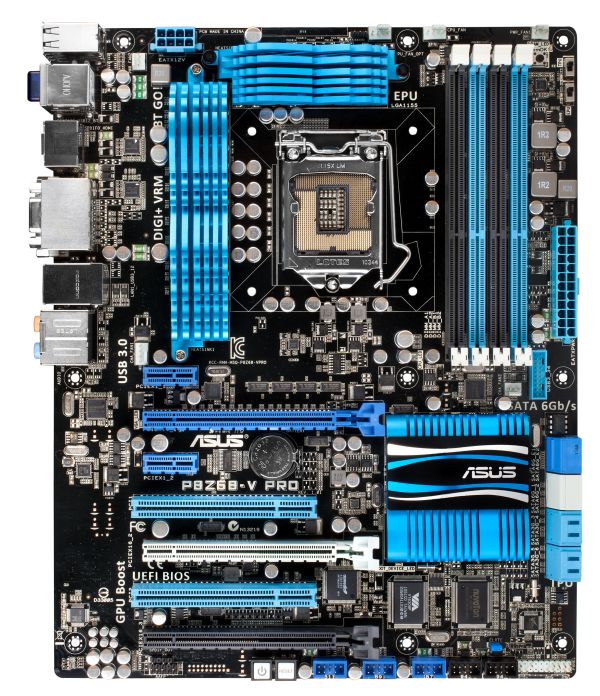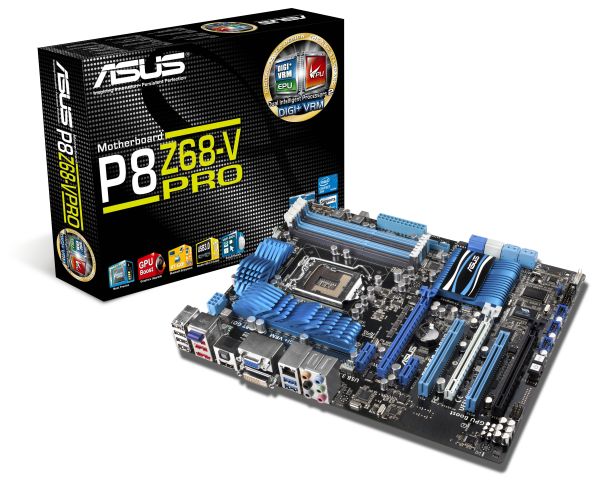ASUS P8Z68-V PRO Review: Our First Z68 Motherboard
by Ian Cutress on May 11, 2011 3:13 AM EST- Posted in
- Motherboards
- Asus
- Z68
ASUS P8Z68-V PRO: Overview
This board from ASUS is a great all-round performer, compared to the P67 boards we have reviewed—space for tri-GPU setups, six fan headers with good OS fan controls, eight SATA ports, six with RAID 0/1/5/10, Intel gigabit Ethernet and it performs well in our benchmark suite. The goods bundled in the box aren't the best we've seen, especially for an expected retail price of $210. But this is a Z68 board—the seemingly logical progression Intel have taken to combine the best bits of P67 and H67, in terms of overclocking. It's thanks to software solutions such as LUCIDLOGIX's Virtu that we can harness both the integrated GPU and discrete GPUs for different work loads—I detail my experiences with Virtu in this review.
ASUS P8Z68-V PRO: Visual Inspection
A quick look at the P8Z67-V PRO board and you might be joining me in thinking it looks almost identical to the P8P67 PRO motherboard. The blue, black and grey livery is still here, with those blue wavy heatsinks covering up the 12 phase CPU and 4 phase iGPU power delivery—unlike other boards, these aren't joined by a heatpipe, and the larger heatsink has a pretty substantial plate connecting the ends on the back of the board.
Around the socket itself, there is one 4-pin chassis fan header near the PCIe 1x, one PWR 3-pin near the 12V CPU power connector, and two CPU fan headers (one 4-pin, one 3-pin) to the top right, which should cover any all-in-one cooling solution with a dual fan and water pump arrangement. Unlike some other Cougar Point motherboards, ASUS have located the PCH to below the DIMM slots, under a large flat heatsink which gets quite warm to touch under normal operation.
Alongside the DIMM slots we have another 3-pin PWR fan header in the top right, just above ASUS' EPU and TPU switches, which activate their Energy Processing Unit and TurboV Processing Units respectively, for lower power usage or automatic overclocking. Enabling both could lead to system instability, however. Underneath these, beyond the 24-pin ATX power connector is a a 3-pin chassis fan header and the USB 3.0 19-pin header. As this is placed here, you would assume ASUS are thinking everyone will be using this header to power a USB 3.0 bracket in the front of the case, rather than the rear. But the supplied USB 3.0 bracket is designed for the rear of the board and doesn't stretch that far, especially over a dual slot GPU should one be in use.
The SATA ports are similar to that found on the P8P67 Pro—the four SATA 3 Gbps from the PCH are in blue, the two SATA 6 Gbps from the PCH are in white, and two SATA 6 Gbps from a Marvell controller. Rather than place the Power/Reset buttons underneath the SATA ports, they are found amongst the myriad of USB and IEEE 1394 headers along the bottom of the board, making them very inconvenient if all three full-size PCIe slots are occupied with dual slot cards.
The PCIe slot arrangement is standard—enough space at the top for a full length PCIe x1 card, with a PCIe x16 slot underneath with a triple slot gap to the next PCIe x16. The three full length PCIe slots run in x16/x0/x4 or x8/x8/x4 mode for GPU setups. However, the bottom PCIe slot shares bandwidth PCIe x1 slots, a two USB ports in the IO panel and the eSATA IO port—all of these are inactive if the bottom PCIe is in x4 mode. By default, the PCIe is in x1 mode, and requires a BIOS setting change for x4.
The IO panel for Z68 boards supporting integrated graphics is a combined mix of previous P67 and H67 iterations, and as such we either lose legacy connections or USB ports infavor of video out ports. There's no PS/2 legacy connector—instead we have on the far left four USB 2.0 ports, then another two USB 2.0 ports, the eSATA 3 Gbps port powered by a JMicron JMB362 controller, and a Bluetooth module. These red USB 2.0 ports/eSATA port are the ones disabled when the third PCIe is in x4 mode. In terms of video outputs, we have a HDMI, DVI and VGA—no display port here, instead you get an optical S/PDIF out (which also means no coaxial S/PDIF out). Just a single gigabit Ethernet port powered by an Intel 82579, and a pair of USB 3.0 ports powered by ASMedia controller. Standard Realtek ALC892 8-channel audio is also present.














95 Comments
View All Comments
AnnihilatorX - Wednesday, May 11, 2011 - link
I wonder when will MB makers start to support onboard multichannel LPCM HDMI audio ?NeBlackCat - Wednesday, May 11, 2011 - link
Would Anandech please remember that some of us care more about running our systems as energy sparingly as possible, and pay as much attention to underclocking/volting as you do to overclocking/volting.It's becoming quite the thing to do, you know. In mid 2011 I really shouldn't have to ask.
NeBlackCat - Wednesday, May 11, 2011 - link
Oops I accidentally posted that as a reply.But since I'm back - any chance you would do a follow up review of the board from an energy saving viewpoint, and incorporate this IMPORTANT aspect into all further board/system reviews, Anandtech?
Dreamwalker - Wednesday, May 11, 2011 - link
Seriusly, if you are after a low power consumption system go look elswhere (Atom, AMD E series, ITX boards...).This segment is made to get the maximum out of your rig and not vice versa.
xinaes - Wednesday, May 11, 2011 - link
Surely these things needn't be polarized. It is not unreasonable to want to know what kind of balance of performance and power can be achieved with any given level of hardware. Also, why should someone interested in economising power not be interested in something like QuickSync, for example?aegisofrime - Wednesday, May 11, 2011 - link
I agree with NeBlackCat. Low power consumption doesn't necessary mean low performance. I for one, undervolt my Phenom II 955. It's a nice balance between performance and power consumption.That said, I have researched undervolting Sandy Bridges before and they seem to do that quite well.
vol7ron - Wednesday, May 11, 2011 - link
I'd also like to know for HTPCs, but I feel if I went that route, I'd stick to an H67 and Core i3/i5 for the cost savings.Still, this is obviously not a complete review, but undervol7ing is something to keep in mind. :)
L. - Thursday, May 12, 2011 - link
2011HTPC
H67 / Z68 / Intel in general
The above three elements are incompatible.
Today, HTPC = E350
Tomorrow, HTPC = E350-likes
For a technical sidenote, undervolting and underclocking are two practices that have been promoted by the lack of chips at every consumption level.
However, again, this is 2011 and you have chips ranging from 1Watt to 125 Watts with steps of maximum 5Watts along the way.
The important fact there is that a chip designed to run @ 18Watts (like an E350) will beat any chip running at that TDP but not designed for it (like an OC'd lower chip or a DC'd higher chip).
As a summary, undervolting is a little fine-tuning you can apply in the end, but it is secondary to picking the correct chip to begin with.
Sandy Bridge can undervolt decently, but seriously WTF.. if you don't need the power, don't pay for it ?
If you're going to undervolt then there's a fairly high chance you're buying the wrong chip.
NeBlackCat - Friday, May 13, 2011 - link
I completely disagree with that.The whole point is that Z68/Sandy Bridge is getting close to giving us the full spectrum of power/performance possibilities in one box (I suspect Ivy Bridge will finish the job), so you DONT have to pick one CPU with one particular profile, and then be restricted in what you can do.
For example:
I may want my HTPC to run at minimal power/noise when watching a movie, but there'll also be times when I want it to rip through an encode as quickly as possible, and don't care if it sounds like a helicopter and glows like hot coal in the process. How nice if i can have both at whim, just with a clock/volt change from a GUI.
I may want my home server to run frugally when just firewalling and media streaming but, when I want to compile that Linux distro...
... and so on.
Z68/Sandy Bridge is perfect for either of the above scenarios. But where hardware/BIOS/tool vendors give us ability to absolutely minimise power/thermals, reviewers don't cover it. Not even a mention of the specs (how low can that vcore go, etc).
They should.
rmoan1 - Wednesday, May 18, 2011 - link
This is silly to me.If you are not using the power then let it auto adjust down at the CPU level. Its like asking if you can fill a Ferrari with regular gas?
Thou I understand why, there is no reason to spend time finding out, none that I can see anyway. If you want to run a media server, along with a browsing PC, etc etc... you can boot into the BIOS OS that comes with all ASUS Boards. You can get a media center ULV PC, etc.. etc... for $300. Or better yet get a tablet when you dont need the full power of your PC.
At the end of the day, you arent getting WD Greens, low power cards, low power RAM, or a smaller PSU or the Green version of the motherboard.
This a performance board that is used for OCing and will be used for OCing.
If you are looking to save energy then stick to a Prius not a Ferrari.